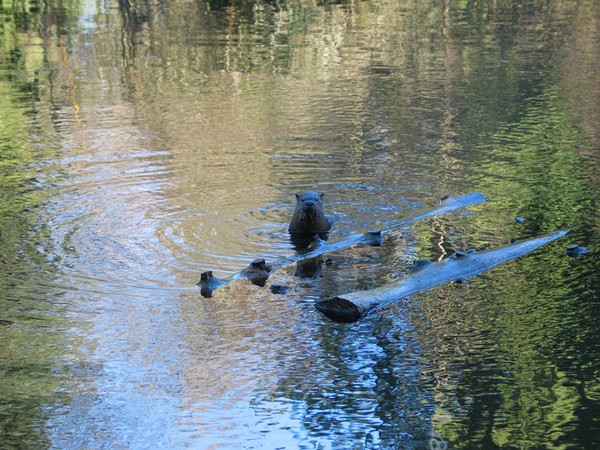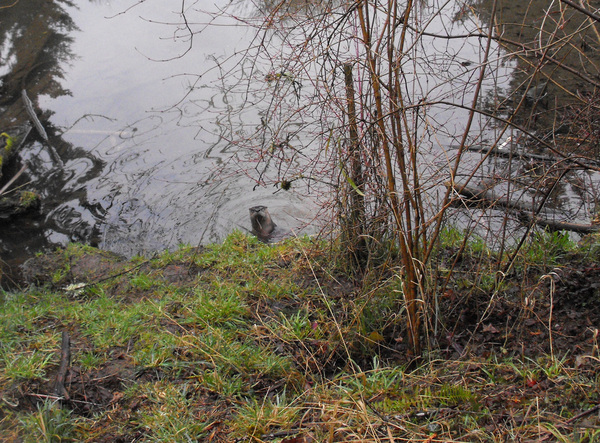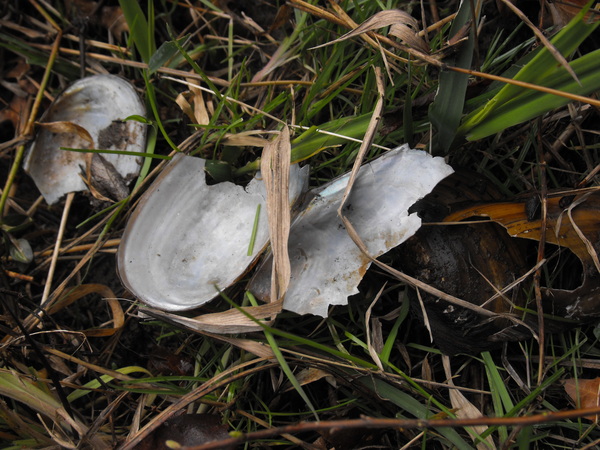Spring brings many changes in the canyon- longer days, the smell of the skunk cabbage in the headwaters, the sounds of birds frolicking in the upper branches of the canopy. But most recently we see this change in seasons welcome a familiar guest, the river otter (Lontra Canadensis).
Although observed in the canyon before – this most recent visit is much earlier than noted in previous wildlife monitoring. Also for the first time since the restoration began in 1999 we’ve seen a ‘family’ of otters.
So the obvious questions seem to be- did our river otter make new friends? Does she live year round in Reed Canyon? And what does she eat?
Last week it was noted that there were three otters frolicking west of the blue bridge near the fish ladder. The lake was calm that day other than the ripples as a result of their playful habits stirring up the lake bottom in their consumption of crustaceans. As I approached closer for a better look I noticed that they were freely swimming in and out of an old beaver den located on the north-bank below the cross canyon dorms- at which point I was spotted- the alarm went off – and one of the otters started to bark and kept a close eye on my actions while the other two darted on the lake bottom under the tree I was standing closest to. Otters are known to be active year round in our waterway, and the seasonal visits by this critter are thought to be more about food shortages downstream and changes in environmental conditions.
So why Reed Canyon? And why now?
River otters seem to prefer permanent watersheds with constant flow. They favor bog lakes with banked shores. Interesting enough otters compete with the American mink for resources (this is the first year we’ve seen mink in Reed Canyon) http://blogs.reed.edu/reed_canyon/2011/11/mink-of-the-week.html.
Otters have few natural predators, but their terrestrial predators do include coyotes. Otters have the ability to easily travel 5 milesin a day. So with that in mind, these otters could have been swimming in the Willamette River the same day they were spotted in the canyon. They probably used the fish ladder to gain access to the upper section of Reed Canyon and the lake area.
Not necessarily nocturnal- these fuzzy critters do seem to be most noticeable during the early morning hours and all but gone by 10am
You can see signs of their nightly feasts by cruising the North-edge of the lake and looking for the remnants of the fresh water mussels.
A family of otters generally consists of an adult female and her progeny. Adult males also establish social groups with other males. Male otters do not seem to be territorial, and allow other dispersing males to join their group.
Groups occur most often in autumn and winter. From mid-winter until the breeding season, female otters move and den alone. River otters breed from December until April. Female river otters do not dig their own dens; they rely on the dens of other mammals, such as beavers.
Litter sizes range from one to three pups. The mothers raise their young without aid from adult males, and she introduces the pups to water when they are about two months old. Pups leave the den at eight weeks, and by fall are capable of sustaining themselves. Before the arrival of the next litter, otter yearlings venture out in search of their home ranges.
These otters may have affects on our resident fish populations and our amphibian migrations. This subject now offers itself to our local scientists and provides opportunities for field research to compare prior populations to current populations and begin to unfold the complex eco-system of our beautiful canyon. After all, the presence of otter in our lake and nearby stream indicates a healthy environment, as they are near the top of the food chain in aquatic systems.


